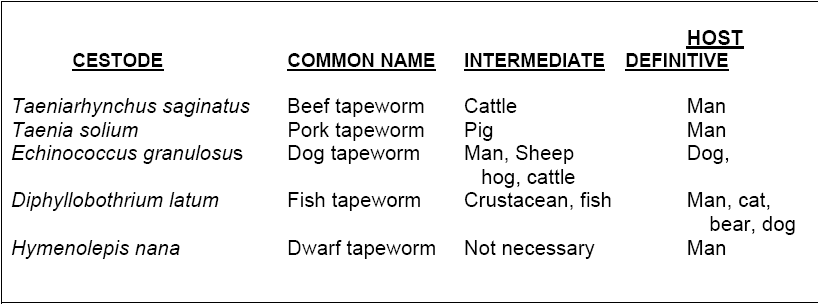Principles of Epidemiology and Microbiology
Lesson 2: Public Health Microbiology
Section V: Protozoa
2-26
2-26. CESTODES (TAPEWORMS)
a. The tapeworm has two stages: larva and adult. The length of an adult worm varies, according to the species, from 3-8 mm to 25 or 30 feet. The adult form has a small head (scolex) and varying numbers of segments (proglottides) (figure 2-15 A&B). The head attaches itself to the intestinal wall of the host by means of suckers. Segments form from the head, receiving their nourishment through absorption, since the worm has no alimentary tract. Each mature segment is a sexually complete hermaphrodite (possessing both male and female sex organs), capable of producing thousands of eggs. Treatment that fails to dislodge the head is ineffective, since the head will immediately begin to replace the lost segments. In most instances a cestode requires both an intermediate host (where certain stages of development occur) and a definitive host (where the adult worm lives and produces ova) to complete its life cycle. Table 2-8 lists the principal cestodes affecting man.
b. When eggs or segments of most tapeworms are passed from the definitive host (man), they are ingested by the intermediate hosts (ruminants, swine, and so forth) while grazing or rummaging for food. The larval stage, a hexacamth oncosphere, hatches and encysts as a cysticercus or cysticercoid larva in the muscles or various organs of the intermediate host. Therefore, the eggs are infective to man and may encyst in tissue as a cysticercus larva resulting in severe complications. In the life cycle of the large fish tapeworm of humans, the eggs must reach water where a larval stage (coracidium) emerges and is swallowed by a small fresh-water crustacean called a copepod that is the first intermediate host. Finally, the infective larval stage (a plerocercoid) developes and encysts in the tissues of the fish. In the life cycle of most tapeworms the infective larval stages attach to the small intestine and become adults when man consumes the improperly prepared flesh of the various intermediate hosts.
Figure 2-15. Tapeworm.

Table 2-8. Principal cestodes affecting man.


